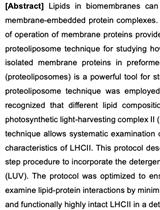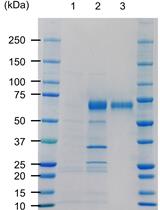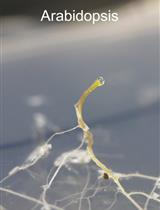- Submit a Protocol
- Receive Our Alerts
- EN
- EN - English
- CN - 中文
- Protocols
- Articles and Issues
- For Authors
- About
- Become a Reviewer
- EN - English
- CN - 中文
- Home
- Protocols
- Articles and Issues
- For Authors
- About
- Become a Reviewer
Extraction of Intracellular and Cell Wall Proteins from Leaves and Roots of Harsh Hakea
Published: Vol 5, Iss 23, Dec 5, 2015 DOI: 10.21769/BioProtoc.1678 Views: 8822
Reviewed by: Arsalan DaudiSollapura J. VishwanathKabin Xie

Protocol Collections
Comprehensive collections of detailed, peer-reviewed protocols focusing on specific topics
Related protocols

Proteoliposomes for Studying Lipid-protein Interactions in Membranes in vitro
Helmut Kirchhoff
Oct 20, 2021 1643 Views

Apoplastic Expression of CARD1-ecto Domain in Nicotiana benthamiana and Purification from the Apoplastic Fluids
Nobuaki Ishihama [...] Ken Shirasu
Apr 20, 2022 1981 Views

Collection of Xylem Exudates from the Model Plant Arabidopsis and the Crop Plant Soybean
Satoru Okamoto and Azusa Kawasaki
Oct 5, 2022 1369 Views
Abstract
Plant proteins can be targeted to intracellular (i.e., cytosol, vacuole, organelles etc.) or extracellular (i.e., cell walls, apoplast) compartments. Dual targeting is a key mechanism with important implications for plant metabolism, growth, development and defense etc. Harsh Hakea (Hakea prostrata R.Br.) is a perennial species and member of the Proteaceae family that thrives on extremely phosphate impoverished soils of southwestern Australia. Harsh Hakea is not a common model organism, but has been widely developed for physiological and molecular/biochemical studies of the endogenous adaptations of an ‘extremophile’ plant species to abiotic stress, including low phosphorus tolerance. Tissues of Harsh Hakea contain large amounts of compounds (e.g., phenolics) that interfere with the extraction of soluble proteins. We previously optimised extraction of intracellular proteins from Harsh Hakea proteoid roots to improve soluble protein yield by at least 10-fold (Shane et al., 2013). Here, we describe the protocol for extraction and separation of intracellular from ‘loosely bound’ cell-wall proteins in Harsh Hakea.
Materials and Reagents
- 2 ml microcentrifuge tubes (Fisher Scientific, catalog number: 05-408-138 )
- Dialysis tubing (12-14 kDa MWCO) (Spectra/Por, Fisher Scientific, catalog number: 08-667B )
- 25 mm syringe filters (0.45 μm) (Sarstedt, catalog number: 83.1826 )
- Harsh Hakea leaves or roots
- Dewar (MVE 20/15) with liquid N2, and ice bucket
- Imidazole (Bioshop, catalog number: IMID508 )
- Triton X-100 (Bioshop, catalog number: TRX777 )
- Glycerol (Bioshop, catalog number: GLY002 )
- Magnesium chloride (Bioshop, catalog number: MAG508 )
- Polyethylene glycol 8000 (Bioshop, catalog number: PEG800 )
- Phenylmethylsulfonyl fluoride (PMSF, G-Biosciences, catalog number: 786-0555 )
- Thiourea (Sigma, catalog number: T-7875 )
- Poly (vinylpolypyrrolidone) (PVPP, Sigma-Aldrich, catalog number: P-6755 )
- Poly (vinylpyrrolidone) (Bioshop, catalog number: PVP504 )
- Intracellular extraction buffer (see Recipes)
- Resuspension buffer (see Recipes)
- Cell wall extraction buffer (see Recipes)
- Dialysis buffer (see Recipes)
Equipment
- ZebaTM spin desalting columns 7K MWCO (0.5 ml) (Fisher Scientific, catalog number: 89882 )
- Porcelain mortar (70 mm inner diameter) and pestle
- Plastic pellet pestle (Kimble-Chase Kontes, Fisher Scientific, catalog number: K749521-0590 )
- Macrosep® Advance Centrifugal Concentrators (10 kDa MWCO) (Pall Corporation, catalog number: MAP010C37 )
- Microcentrifuge (Beckman Coulter, model: microfuge 22R )
- PT-3100 Polytron Homogenizer (Kinematica, model: PT-3100)
- Magnetic stirrer
- 4 °C cold room
Procedure
This protocol applies to extraction of intracellular and cell-wall proteins from Harsh Hakea leaves, but can also be applied to roots (e.g., Shane et al., 2014; Shane et al., 2013). For protocols optimized for extracting intracellular and cell wall proteins from leaves, stems etc. of the model plant Arabidopsis thaliana see Shane et al. (2014); Shane et al. (2013) and Robinson et al. (2012).
- Extraction of soluble intracellular proteins
- Quickly freeze freshly harvested tissues in liquid N2. Store at -80 °C until use.
- Grind frozen tissues (e.g., ~1 g, comprising a biological replicate) to a powder under liquid N2 using a pre-chilled mortar and pestle.
- Transfer an aliquot (e.g., ~200 mg) of frozen tissue powder to a pre-cooled, 2 ml microcentrifuge tube. Do not allow tissue to thaw during this step. Maintain samples in liquid N2 until all samples are weighed out.
- Add ice-cold Intracellular extraction buffer (IEB) at 1:4 (w/v) to each sample and vortex until tissue thaws into extraction buffer. Briefly homogenize sample using the Polytron (2 to 4 pulses at high speed for 10 to 15 sec per pulse) while maintaining the microcentrifuge tube on ice. Retain homogenates on ice until all extractions are completed (it is recommended not to exceed 8 to 10 samples per batch to reduce probability of protein proteolysis etc.).
- Centrifuge homogenates at 17,500 x g for 15 min at 4 °C.
- Carefully pipette off supernatant (clarified extract) and desalt using a ZebaTM spin desalting column previously equilibrated in IEB lacking PVPP and PVP. The desalted extract is designated the intracellular fraction of soluble proteins (e.g., ~2-10 mg protein/ml depending upon the tissue type and stage of development).
- Quickly freeze freshly harvested tissues in liquid N2. Store at -80 °C until use.
- Washing the insoluble pellets
- The pellet containing insoluble cell debris is washed twice by resuspending in 1.5-2.0 ml of re-suspension buffer (RB) using a pellet pestle, and centrifugation as above (supernatants are discarded).
- The pellet is washed as above an additional four times in RB lacking Triton X-100. When completely washed, the pellets will be nearly colourless.
- The pellet containing insoluble cell debris is washed twice by resuspending in 1.5-2.0 ml of re-suspension buffer (RB) using a pellet pestle, and centrifugation as above (supernatants are discarded).
- Extraction of cell-wall bound proteins
- The extraction of cell wall proteins from the washed insoluble pellets is done using a cell wall extraction buffer (CWEB) (see Recipes) (~ 2 ml) while stirring for 30 min at 4 °C.
- Samples are centrifuged as above and concentrated using the Macrosep® centrifugal concentrator to ~0.2 ml yielding a protein concentration of ~2 mg/ml [for spectrophotometric determination of protein concentration see Knowles and Plaxton (2013)].
- Clarify extracts by passing through the 0.45 syringe filter, and then dialyse overnight at 4 °C against 4 L of the dialysis buffer (DB) using Spectra/Por dialysis tubing (12-14 kDa MWCO, 25 mm flat width).
- The resultant sample contains ‘loosely-bound’ cell-wall proteins.
- SDS-PAGE of the cell wall versus intracellular fractions followed by immunoblotting using anti-aldolase and anti-phosphoenolpyruvate carboxylase antibodies is performed to confirm absence of immunoreactive -40 kDa aldolase and -100 kDa phosphoenolpyruvate carboxylase polypeptides (i.e., cytoplasmic marker proteins) in the cell wall extracts [for detailed procedure see Shane et al. (2014)].
- The extraction of cell wall proteins from the washed insoluble pellets is done using a cell wall extraction buffer (CWEB) (see Recipes) (~ 2 ml) while stirring for 30 min at 4 °C.
Recipes
All buffers are made up fresh the day before and stored at 4 °C until used, but no sterilization was done.
- Intracellular extraction buffer (IEB, keep on ice)
50 mM imidazole-HCl (pH 7.0)
0.1% (v/v) Triton X-100
10% (v/v) glycerol
10 mM thiourea
2 mM MgCl2
2% (w/v) polyethylene glycol 8,000
1% (w/v) polyvinyl (polypyrrolidone) (PVPP)
Note: Add fresh to IEB immediately prior to tissue extraction.
1% (w/v) polyvinylpyrrolidone (PVP)
Note: Add fresh to IEB immediately prior to tissue extraction.
1 mM phenylmethylsulphonyl fluoride (PMSF)
Notes:- Add fresh to IEB immediately prior to tissue extraction.
- Prepare a 100 mM stock of PMSF in absolute ethanol and store at -20 °C; PMSF is unstable in aqueous solution. Handle PMSF with care as this protease inhibitor is quite toxic.
- Add fresh to IEB immediately prior to tissue extraction.
- Resuspension buffer (RB, keep in ice)
50 mM Tris-HCl (pH 7.4)
10 mM MgCl2
1% (v/v) Triton X-100 - Cell wall extraction buffer (CWEB, keep in ice)
1 M NaCl in 40 mM Tris-HCl (pH 7.4)
10 mM MgCl2 - Dialysis buffer (DB, keep in 4 °C cold room)
40 mM Tris-HCl (pH 7.4)
10 mM MgCl2
Acknowledgments
This work was supported by the Australian Research Council (grant no. DP1092856 to M. W. S.), as well as grants from the Natural Sciences and Engineering Research Council of Canada and Queen’s Research Chairs program (to W. C. P.).
References
- Knowles, V. and Plaxton, W. (2013). Protein extraction, acid phosphatase activity assays, and determination of soluble protein concentration. Bio-protocol 3(17): e889.
- Shane, M. W., Fedosejevs, E. T. and Plaxton, W. C. (2013). Reciprocal control of anaplerotic phosphoenolpyruvate carboxylase by in vivo monoubiquitination and phosphorylation in developing proteoid roots of phosphate-deficient harsh hakea. Plant Physiol 161(4): 1634-1644.
- Shane, M. W., Stigter, K., Fedosejevs, E. T. and Plaxton, W. C. (2014). Senescence-inducible cell wall and intracellular purple acid phosphatases: implications for phosphorus remobilization in Hakea prostrata (Proteaceae) and Arabidopsis thaliana (Brassicaceae). J Exp Bot 65(20): 6097-6106.
- Robinson, W. D., Park, J., Tran, H. T., Del Vecchio, H. A., Ying, S., Zins, J. L., Patel, K., McKnight, T. D. and Plaxton, W. C. (2012). The secreted purple acid phosphatase isozymes AtPAP12 and AtPAP26 play a pivotal role in extracellular phosphate-scavenging by Arabidopsis thaliana. J Exp Bot 63(18): 6531-6542.
Article Information
Copyright
© 2015 The Authors; exclusive licensee Bio-protocol LLC.
How to cite
Shane, M. W. and Plaxton, W. (2015). Extraction of Intracellular and Cell Wall Proteins from Leaves and Roots of Harsh Hakea. Bio-protocol 5(23): e1678. DOI: 10.21769/BioProtoc.1678.
Category
Plant Science > Plant biochemistry > Protein
Plant Science > Plant cell biology > Tissue analysis
Do you have any questions about this protocol?
Post your question to gather feedback from the community. We will also invite the authors of this article to respond.
Tips for asking effective questions
+ Description
Write a detailed description. Include all information that will help others answer your question including experimental processes, conditions, and relevant images.
Share
Bluesky
X
Copy link








